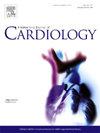经导管主动脉瓣置换术患者心外膜脂肪组织动态变化的预后作用。
IF 3.2
2区 医学
Q2 CARDIAC & CARDIOVASCULAR SYSTEMS
引用次数: 0
摘要
背景:心外膜脂肪组织(EAT)体积与心血管事件风险有关,可通过心脏计算机断层扫描进行评估。然而,经导管主动脉瓣置换术(TAVR)患者的最佳方法及其预后效用尚不清楚:我们对 258 名参与者进行了评估,重点是使用心脏 CT 增强技术观察 EAT 体积的变化。EAT体积自动计算为对比增强切片上-190至-30 HU之间的三维体素。进行了单变量和多变量考克斯回归分析,以评估各种临床参数和EAT体积指数与主要不良心血管事件(MACE)的关系:在中位随访 2.0 年[IQR, 1.8-2.3 年]期间,34 名参与者(中位年龄 73 [IQR: -13.1--8.3]岁,55.4% 为男性)经历了 MACE。根据尤登指数(Youden-index),EAT体积变化分数(EATVCF)的最佳临界值为15.2%。Kaplan-Meier 曲线分析表明,EATVCF 高的患者风险更高(p 结论:EATVCF 是导致急性心肌梗死的重要因素:EAT容积变化分数是预测TAVR术后MACE的一个重要指标,凸显了EAT容积评估在心血管风险分层中的临床价值。本文章由计算机程序翻译,如有差异,请以英文原文为准。
Prognostic utility of dynamic changes in epicardial adipose tissue in patients undergoing transcatheter aortic valve replacement
Background
Epicardial Adipose Tissue (EAT) volume is associated with the risk of cardiovascular events, which can be assessed by cardiac computed tomography. However, he optimal method and their prognostic utility in patients following transcatheter aortic valve replacement (TAVR) is unknown.
Methods
We evaluated 258 participants, focusing on changes in EAT volume using cardiac CT enhancement. EAT volume was automatically computed as three-dimensional voxels between −190 to −30 HU on contrast-enhanced slices. Univariate and multivariable Cox regression analyses were conducted to assess the association of various clinical parameters and EAT volume indices with major adverse cardiovascular events (MACE).
Results
During a median follow-up of 2.0 years [IQR, 1.8–2.3 years], 34 participants (median age 73 [IQR: −13.1 to −8.3) years, 55.4 % male) experiencing MACE. The optimal cutoff values for EAT volume change fraction (EATVCF) was 15.2 %, determined by the Youden-index. Kaplan-Meier curve analysis revealed that patients with high EATVCF were at higher risk (p < .01). In Cox regression, EATVCF (hazard ratio [HR]: 0.92, 95 % CI: 0.87 to 0.97, p = .001) remained significantly associated with MACE after adjusting for clinical factors. The addition of EATVCF to the clinical model increased the net Reclassification Improvement (NRI) by 30.1 % (95 % CI: 0.07–1.16).
Conclusion
EAT volume change fraction emerged as a significant predictor of MACE post-TAVR, highlighting the clinical value of EAT volume assessment in cardiovascular risk stratification.
求助全文
通过发布文献求助,成功后即可免费获取论文全文。
去求助
来源期刊

International journal of cardiology
医学-心血管系统
CiteScore
6.80
自引率
5.70%
发文量
758
审稿时长
44 days
期刊介绍:
The International Journal of Cardiology is devoted to cardiology in the broadest sense. Both basic research and clinical papers can be submitted. The journal serves the interest of both practicing clinicians and researchers.
In addition to original papers, we are launching a range of new manuscript types, including Consensus and Position Papers, Systematic Reviews, Meta-analyses, and Short communications. Case reports are no longer acceptable. Controversial techniques, issues on health policy and social medicine are discussed and serve as useful tools for encouraging debate.
 求助内容:
求助内容: 应助结果提醒方式:
应助结果提醒方式:


